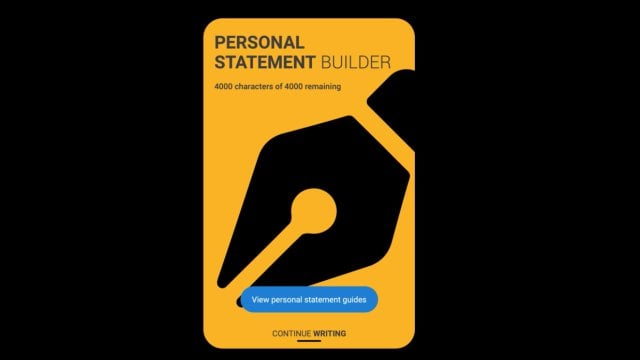What is the personal statement builder?
The personal statement builder in the UCAS Hub is designed to help you think about what to include in your personal statement, and how to lay it all out. It also counts how many characters you’ve used, so it’s easy to see when you’re close to the 4,000 character limit.
All you have to do is sign up for the UCAS Hub and then you’ll be able to see how to break your personal statement down into sections, making it easier to arrange your thoughts.
Personal statement builder features
Once you’ve registered in the UCAS Hub, you can begin to order your thoughts by working through the personal statement builder. You’ll find it on the grid of content on your Hub home page.
The personal statement builder breaks down the content you need for your statement into three key areas:
- Writing about the course.
- Skills and achievements.
- Work experience and future plans.
Within each of those sections there are questions to help you think of what to write.
- For example, in the first section – writing about the course – there are prompts like: Why are you applying for the chosen course(s)? Why does the subject interest you?
- The second section, about skills and achievements, will ask you to include things about the skills you have that’ll help you, and any supporting evidence to back up why you’re so excited about the course(s) you have chosen – alongside other achievements you’re proud of and/or positions of responsibility you’ve held.
- The final section will give you prompts to help you think about any work or voluntary experience you have and how you can relate that – or the abilities you gained – to the course(s) you want to study.
Once you’ve written your answers in the personal statement builder, you can preview and then export it as a PDF or copy and paste it into a Word document to save it, using the built-in functionality.
There’s also a link within the builder to our dedicated personal statement hub, where you can find guides with lots of extra information around writing it, including:
- how to begin a personal statement
- what things you should and shouldn’t include
- what to do if you have alternative arrangements
Also, even if you don’t end up applying to university, using the personal statement builder is a great way to practise writing about your skills and experience you can then use in your CV or an apprenticeship application.
How to use the personal statement builder

Don’t be tempted to copy or share your statement
UCAS scans all personal statements through a similarity detection system to compare them with previous statements.
Any similarity greater than 30% will be flagged and we'll inform the universities and colleges to which you have applied.
Find out more
- Do sign up for the UCAS Hub to use the personal statement builder.
- Do use the personal statement builder to break the work down into sections.
- Do make notes about all your relevant experiences and hobbies.
- Don’t worry about your personal statement – we have resources to help you.
- Don’t feel you need to complete it all in one go – take breaks and come back to it.
- Don't forget to think about the things that make you stand out.
- Don’t be tempted to copy or share your personal statement.
- Don’t use artificial intelligence software or writing service providers.